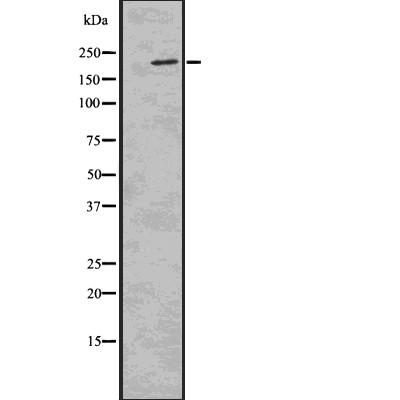| 产品: | 磷酸化 53BP1 (Ser25/Ser29) 抗体 |
| 货号: | DF2977 |
| 描述: | Rabbit polyclonal antibody to Phospho-53BP1 (Ser25/Ser29) |
| 应用: | WB IF/ICC |
| 反应: | Human, Mouse, Rat, Monkey |
| 预测: | Pig, Horse, Sheep, Rabbit, Dog |
| 分子量: | 220KD; 214kD(Calculated). |
| 蛋白号: | Q12888 |
| RRID: | AB_2840957 |
产品描述
*The optimal dilutions should be determined by the end user.
*Tips:
WB: 适用于变性蛋白样本的免疫印迹检测. IHC: 适用于组织样本的石蜡(IHC-p)或冰冻(IHC-f)切片样本的免疫组化/荧光检测. IF/ICC: 适用于细胞样本的荧光检测. ELISA(peptide): 适用于抗原肽的ELISA检测.
引用格式: Affinity Biosciences Cat# DF2977, RRID:AB_2840957.
展开/折叠
53 BP1; 53BP1; FLJ41424; MGC138366; p202; p53 binding protein 1; p53 BP1; p53-binding protein 1; p53BP1; TP53 BP1; TP53B_HUMAN; Tp53bp1; TRP53 BP1; Tumor protein 53 binding protein 1; Tumor protein p53 binding protein 1; Tumor suppressor p53 binding protein 1; Tumor suppressor p53-binding protein 1;
抗原和靶标
A synthesized peptide derived from human 53BP1 around the phosphorylation site of Ser25/29.
- Q12888 TP53B_HUMAN:
- Protein BLAST With
- NCBI/
- ExPASy/
- Uniprot
MDPTGSQLDSDFSQQDTPCLIIEDSQPESQVLEDDSGSHFSMLSRHLPNLQTHKENPVLDVVSNPEQTAGEERGDGNSGFNEHLKENKVADPVDSSNLDTCGSISQVIEQLPQPNRTSSVLGMSVESAPAVEEEKGEELEQKEKEKEEDTSGNTTHSLGAEDTASSQLGFGVLELSQSQDVEENTVPYEVDKEQLQSVTTNSGYTRLSDVDANTAIKHEEQSNEDIPIAEQSSKDIPVTAQPSKDVHVVKEQNPPPARSEDMPFSPKASVAAMEAKEQLSAQELMESGLQIQKSPEPEVLSTQEDLFDQSNKTVSSDGCSTPSREEGGCSLASTPATTLHLLQLSGQRSLVQDSLSTNSSDLVAPSPDAFRSTPFIVPSSPTEQEGRQDKPMDTSVLSEEGGEPFQKKLQSGEPVELENPPLLPESTVSPQASTPISQSTPVFPPGSLPIPSQPQFSHDIFIPSPSLEEQSNDGKKDGDMHSSSLTVECSKTSEIEPKNSPEDLGLSLTGDSCKLMLSTSEYSQSPKMESLSSHRIDEDGENTQIEDTEPMSPVLNSKFVPAENDSILMNPAQDGEVQLSQNDDKTKGDDTDTRDDISILATGCKGREETVAEDVCIDLTCDSGSQAVPSPATRSEALSSVLDQEEAMEIKEHHPEEGSSGSEVEEIPETPCESQGEELKEENMESVPLHLSLTETQSQGLCLQKEMPKKECSEAMEVETSVISIDSPQKLAILDQELEHKEQEAWEEATSEDSSVVIVDVKEPSPRVDVSCEPLEGVEKCSDSQSWEDIAPEIEPCAENRLDTKEEKSVEYEGDLKSGTAETEPVEQDSSQPSLPLVRADDPLRLDQELQQPQTQEKTSNSLTEDSKMANAKQLSSDAEAQKLGKPSAHASQSFCESSSETPFHFTLPKEGDIIPPLTGATPPLIGHLKLEPKRHSTPIGISNYPESTIATSDVMSESMVETHDPILGSGKGDSGAAPDVDDKLCLRMKLVSPETEASEESLQFNLEKPATGERKNGSTAVAESVASPQKTMSVLSCICEARQENEARSEDPPTTPIRGNLLHFPSSQGEEEKEKLEGDHTIRQSQQPMKPISPVKDPVSPASQKMVIQGPSSPQGEAMVTDVLEDQKEGRSTNKENPSKALIERPSQNNIGIQTMECSLRVPETVSAATQTIKNVCEQGTSTVDQNFGKQDATVQTERGSGEKPVSAPGDDTESLHSQGEEEFDMPQPPHGHVLHRHMRTIREVRTLVTRVITDVYYVDGTEVERKVTEETEEPIVECQECETEVSPSQTGGSSGDLGDISSFSSKASSLHRTSSGTSLSAMHSSGSSGKGAGPLRGKTSGTEPADFALPSSRGGPGKLSPRKGVSQTGTPVCEEDGDAGLGIRQGGKAPVTPRGRGRRGRPPSRTTGTRETAVPGPLGIEDISPNLSPDDKSFSRVVPRVPDSTRRTDVGAGALRRSDSPEIPFQAAAGPSDGLDASSPGNSFVGLRVVAKWSSNGYFYSGKITRDVGAGKYKLLFDDGYECDVLGKDILLCDPIPLDTEVTALSEDEYFSAGVVKGHRKESGELYYSIEKEGQRKWYKRMAVILSLEQGNRLREQYGLGPYEAVTPLTKAADISLDNLVEGKRKRRSNVSSPATPTASSSSSTTPTRKITESPRASMGVLSGKRKLITSEEERSPAKRGRKSATVKPGAVGAGEFVSPCESGDNTGEPSALEEQRGPLPLNKTLFLGYAFLLTMATTSDKLASRSKLPDGPTGSSEEEEEFLEIPPFNKQYTESQLRAGAGYILEDFNEAQCNTAYQCLLIADQHCRTRKYFLCLASGIPCVSHVWVHDSCHANQLQNYRNYLLPAGYSLEEQRILDWQPRENPFQNLKVLLVSDQQQNFLELWSEILMTGGAASVKQHHSSAHNKDIALGVFDVVVTDPSCPASVLKCAEALQLPVVSQEWVIQCLIVGERIGFKQHPKYKHDYVSH
种属预测
score>80的预测可信度较高,可尝试用于WB检测。*预测模型主要基于免疫原序列比对,结果仅作参考,不作为质保凭据。
High(score>80) Medium(80>score>50) Low(score<50) No confidence
研究背景
Double-strand break (DSB) repair protein involved in response to DNA damage, telomere dynamics and class-switch recombination (CSR) during antibody genesis. Plays a key role in the repair of double-strand DNA breaks (DSBs) in response to DNA damage by promoting non-homologous end joining (NHEJ)-mediated repair of DSBs and specifically counteracting the function of the homologous recombination (HR) repair protein BRCA1. In response to DSBs, phosphorylation by ATM promotes interaction with RIF1 and dissociation from NUDT16L1/TIRR, leading to recruitment to DSBs sites. Recruited to DSBs sites by recognizing and binding histone H2A monoubiquitinated at 'Lys-15' (H2AK15Ub) and histone H4 dimethylated at 'Lys-20' (H4K20me2), two histone marks that are present at DSBs sites. Required for immunoglobulin class-switch recombination (CSR) during antibody genesis, a process that involves the generation of DNA DSBs. Participates to the repair and the orientation of the broken DNA ends during CSR (By similarity). In contrast, it is not required for classic NHEJ and V(D)J recombination (By similarity). Promotes NHEJ of dysfunctional telomeres via interaction with PAXIP1.
Asymmetrically dimethylated on Arg residues by PRMT1. Methylation is required for DNA binding.
Phosphorylated at basal level in the absence of DNA damage. Phosphorylated by ATM in response to DNA damage: phosphorylation at different sites promotes interaction with different set of proteins: phosphorylation at the N-terminus by ATM (residues from 6-178) promotes interaction with PAXIP1 and non-homologous end joining (NHEJ) of dysfunctional telomeres. Phosphorylation by ATM at residues that are located more C-terminus (residues 300-650) leads to promote interaction with RIF1. Interaction with RIF1 leads to disrupt interaction with NUDT16L1/TIRR. Phosphorylation at Thr-1609 and Ser-1618 in the UDR motif blocks interaction with H2AK15ub. Dephosphorylated by PPP4C. Hyperphosphorylation during mitosis correlates with its exclusion from chromatin and DNA lesions. Hyperphosphorylated in an ATR-dependent manner in response to DNA damage induced by UV irradiation. Dephosphorylated by PPP5C.
Nucleus. Chromosome. Chromosome>Centromere>Kinetochore.
Note: Localizes to the nucleus in absence of DNA damage (PubMed:28241136). Following DNA damage, recruited to sites of DNA damage, such as double stand breaks (DSBs): recognizes and binds histone H2A monoubiquitinated at 'Lys-15' (H2AK15Ub) and histone H4 dimethylated at 'Lys-20' (H4K20me2), two histone marks that are present at DSBs sites (PubMed:23333306, PubMed:23760478, PubMed:24703952, PubMed:28241136, PubMed:17190600). Associated with kinetochores during mitosis (By similarity).
The Tudor-like region mediates binding to histone H4 dimethylated at 'Lys-20' (H4K20me2) (PubMed:17190600). Interaction with NUDT16L1/TIRR masks the Tudor-like domain and prevents recruitment to chromatin (PubMed:28241136).
The UDR (ubiquitin-dependent recruitment) motif specifically recognizes and binds histone H2A monoubiquitinated at 'Lys-15' (H2AK15ub) (PubMed:23760478, PubMed:24703952). Phosphorylation of the UDR blocks interaction with H2AK15ub (PubMed:24703952).
研究领域
· Organismal Systems > Immune system > NOD-like receptor signaling pathway. (View pathway)
限制条款
产品的规格、报价、验证数据请以官网为准,官网链接:www.affbiotech.com | www.affbiotech.cn(简体中文)| www.affbiotech.jp(日本語)产品的数据信息为Affinity所有,未经授权不得收集Affinity官网数据或资料用于商业用途,对抄袭产品数据的行为我们将保留诉诸法律的权利。
产品相关数据会因产品批次、产品检测情况随时调整,如您已订购该产品,请以订购时随货说明书为准,否则请以官网内容为准,官网内容有改动时恕不另行通知。
Affinity保证所销售产品均经过严格质量检测。如您购买的商品在规定时间内出现问题需要售后时,请您在Affinity官方渠道提交售后申请。产品仅供科学研究使用。不用于诊断和治疗。
产品未经授权不得转售。
Affinity Biosciences将不会对在使用我们的产品时可能发生的专利侵权或其他侵权行为负责。Affinity Biosciences, Affinity Biosciences标志和所有其他商标所有权归Affinity Biosciences LTD.

